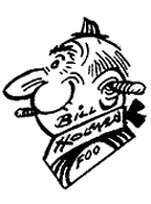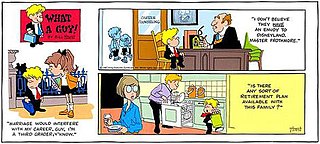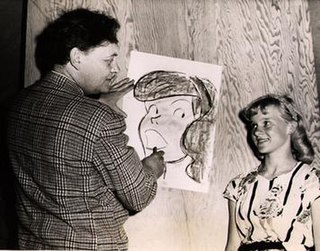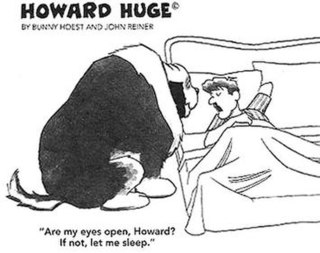
A cartoon is a type of visual art that is typically drawn, frequently animated, in an unrealistic or semi-realistic style. The specific meaning has evolved, but the modern usage usually refers to either: an image or series of images intended for satire, caricature, or humor; or a motion picture that relies on a sequence of illustrations for its animation. Someone who creates cartoons in the first sense is called a cartoonist, and in the second sense they are usually called an animator.

Curtis Arnoux Peters, Jr., known professionally as Peter Arno, was an American cartoonist. He contributed cartoons and 101 covers to The New Yorker from 1925, the magazine's first year, until 1968, the year of his death. In 2015, New Yorker contributor Roger Angell described him as "the magazine's first genius".

King Features Syndicate, Inc. is an American content distribution and animation studio, consumer product licensing and print syndication company owned by Hearst Communications that distributes about 150 comic strips, newspaper columns, editorial cartoons, puzzles, and games to nearly 5,000 newspapers worldwide. King Features Syndicate also produces intellectual properties, develops new content and franchises, like The Cuphead Show!, which it produced with Netflix, and licenses its classic characters and properties. King Features Syndicate is a unit of Hearst Holdings, Inc., which combines the Hearst Corporation's cable-network partnerships, television programming and distribution activities, and syndication companies. King Features' affiliate syndicates are North America Syndicate and Cowles Syndicate.

Parade was an American nationwide Sunday newspaper magazine, distributed in more than 700 newspapers in the United States until 2022. The most widely read magazine in the U.S., Parade had a circulation of 32 million and a readership of 54.1 million. Anne Krueger has been the magazine's editor since 2015.

She Was an Acrobat's Daughter is an animated short in the Merrie Melodies series, produced by Vitaphone Productions and released by Warner Bros. Pictures, Inc. on April 10, 1937. This animated short was directed by I. Freleng and produced by Leon Schlesinger.

The Lockhorns is a United States single-panel cartoon created September 9, 1968 by Bill Hoest and distributed by King Features Syndicate to 500 newspapers in 23 countries. It is continued today by Bunny Hoest and John Reiner.
Bunny Hoest, sometimes labeled The Cartoon Lady, is the writer of several comic strips, including The Lockhorns, Laugh Parade, and Howard Huge, the first of which she inherited from her late husband Bill Hoest. She is the co-creator of Bumper Snickers in 1974, Agatha Crumm in 1977, Laugh Parade in 1980, Howard Huge in 1981, What A Guy! in 1986, and Hunny Bunny's Short Tales in 1992.

John Reiner is a cartoonist who collaborates with writer Bunny Hoest on three cartoon series: The Lockhorns, syndicated by King Features, and Laugh Parade and Howard Huge.

William Pierce Hoest was an American cartoonist best known as the creator of the gag panel series, The Lockhorns, distributed by King Features Syndicate to 500 newspapers in 23 countries, and Laugh Parade for Parade. He also created other syndicated strips and panels for King Features.

Henry Boltinoff was an American cartoonist who worked for both comic strips and comic books. He was a prolific cartoonist and drew many of the humor and filler strips that appeared in National Periodical comics from the 1940s through the 1960s.
John Joseph Gallagher (1926–2005) was an American cartoonist and illustrator. He contributed to most major magazines in the 1950s and 1960s, signing his work “Gallagher.” He won the National Cartoonist Society Gag Cartoon Award in 1957 and 1971.
Glenn McCoy is a conservative American cartoonist, whose work includes the comic strip The Duplex and the daily panel he does with his brother Gary entitled The Flying McCoys. McCoy previously produced editorial cartoons until May 2018, when he refocused his career on animations after being discharged from his job of 22 years at the Belleville News-Democrat. All three cartoon features are syndicated by Andrews McMeel Syndication.
The Stupid Cupid is a 1944 Warner Bros. Looney Tunes animated cartoon directed by Frank Tashlin. The cartoon was released on November 25, 1944, and stars Daffy Duck and Elmer Fudd.

Jay Malcolm Kennedy was an American editor and writer. The author of The Official Underground and Newave Comix Price Guide, he was a long-time editor at King Features Syndicate, eventually rising to the position of editor-in-chief.

Bill Holman was an American cartoonist who drew the classic comic strip Smokey Stover from 1935 until he retired in 1973. Distributed through the Chicago Tribune syndicate, it had the longest run of any strip in the screwball genre. Holman signed some strips with the pseudonym Scat H. He once described himself as "always inclined to humor and acting silly."

What a Guy! is an American comic strip created by Bill Hoest and Bunny Hoest, the team responsible for The Lockhorns and Agatha Crumm. It began in March 1987, just over a year before Hoest's death in 1988.
Rina Piccolo is a Canadian cartoonist, best known for her comic strip Tina's Groove, distributed by King Features Syndicate since 2002. She has been a professional cartoonist for more than two decades and recently gained recognition as an author of short stories. Since 2016, she has assisted Hillary Price on the comic strip Rhymes with Orange.

Harry William Haenigsen was an American illustrator and cartoonist best known for Penny, his comic strip about a teenage girl. He also illustrated for books, magazines and advertising.

Howard Huge is a cartoon series written by Bunny Hoest and illustrated by John Reiner. Created by Bill Hoest, the series had 80 million readers, since it ran in the Sunday supplement magazine, Parade from 1980 to 2007, continuing on a website.
Hal Sherman was a gag cartoonist and a Platinum Age and Golden Age comic book artist. He is best remembered for his work on the Star-Spangled Kid, which he co-created with Jerry Siegel, who had previously co-created Superman.














